Workforce Conflict Management: Coaching Techniques at Tesco Analysis
VerifiedAdded on 2023/06/15
|9
|2911
|418
Essay
AI Summary
This essay explores conflict management and the application of coaching techniques within the context of Tesco, focusing on a case study of resistance to change during the introduction of AI-powered checkout-free stores. It discusses different types of workplace conflicts, stages of conflict escalation, and various conflict management styles, emphasizing the importance of conflict resolution for maintaining a positive work environment. The essay also delves into conflict resolution techniques such as negotiation, mediation, arbitration, and litigation, and applies Gibb's reflective cycle to analyze the learning experience for managers. Furthermore, it differentiates between coaching and mentoring, examines various coaching techniques like autocratic, democratic, and holistic coaching, and applies the GROW model to reduce employee resistance to change. The conclusion highlights the necessity of effective conflict resolution for ensuring smooth operations and maintaining employee satisfaction at Tesco.
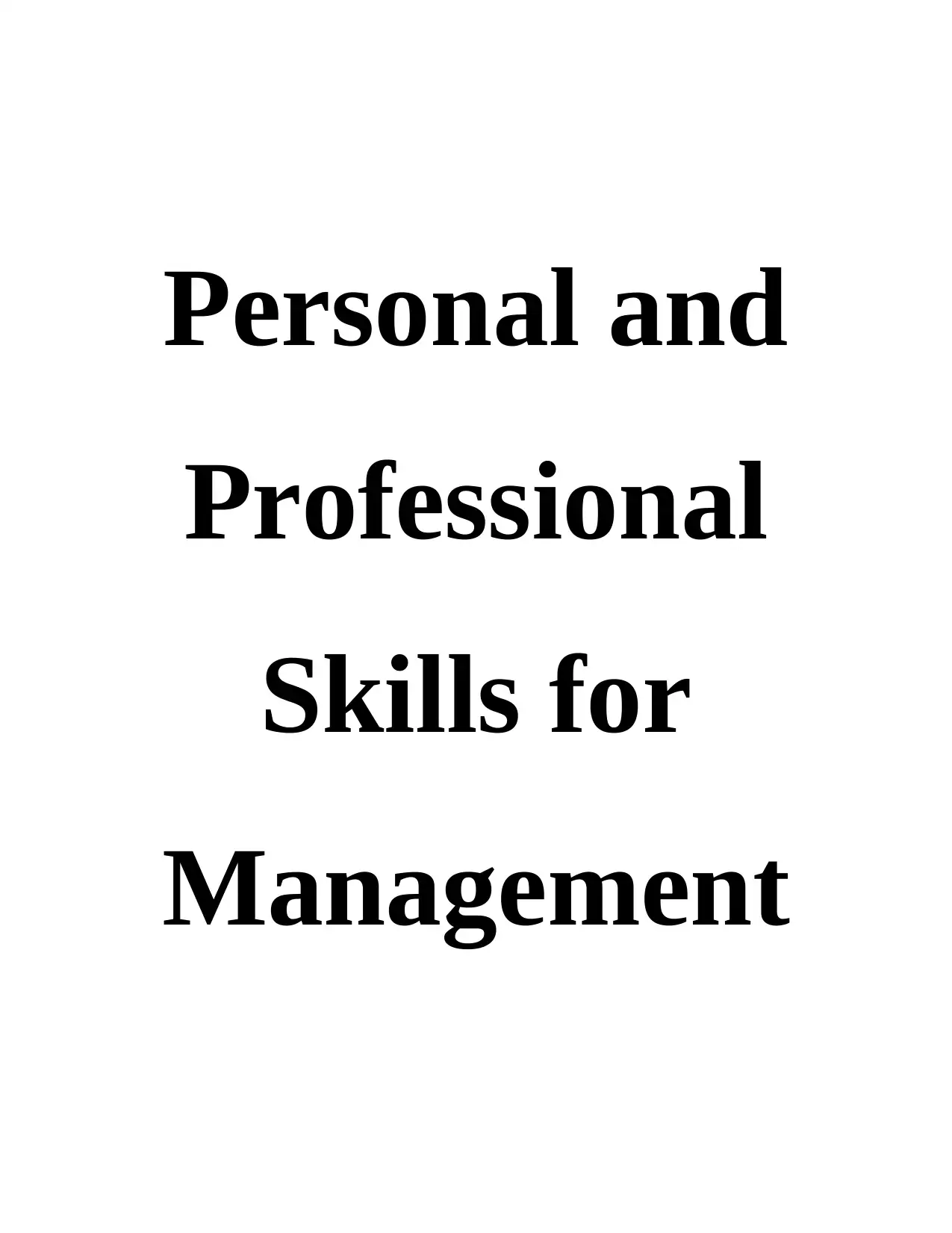
Personal and
Professional
Skills for
Management
Professional
Skills for
Management
Paraphrase This Document
Need a fresh take? Get an instant paraphrase of this document with our AI Paraphraser
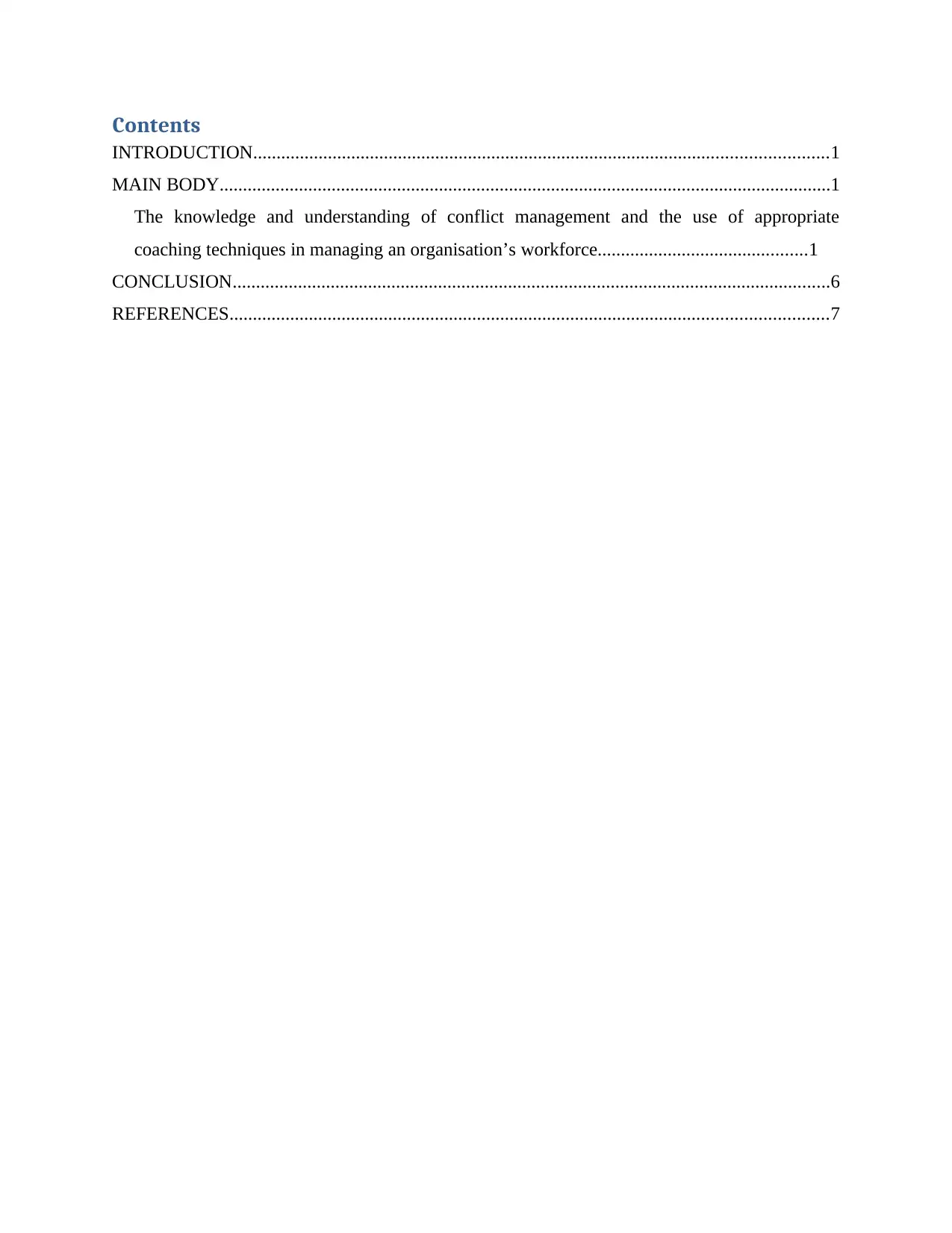
Contents
INTRODUCTION...........................................................................................................................1
MAIN BODY...................................................................................................................................1
The knowledge and understanding of conflict management and the use of appropriate
coaching techniques in managing an organisation’s workforce.............................................1
CONCLUSION................................................................................................................................6
REFERENCES................................................................................................................................7
INTRODUCTION...........................................................................................................................1
MAIN BODY...................................................................................................................................1
The knowledge and understanding of conflict management and the use of appropriate
coaching techniques in managing an organisation’s workforce.............................................1
CONCLUSION................................................................................................................................6
REFERENCES................................................................................................................................7

INTRODUCTION
Business firms face various conflict during daily operations of the company and it is
important for management level employees at the enterprise to ensure that the daily effective
functioning of the firm (Ahani and Dadashpoor, 2021). The aim of this essay is to develop
knowledge about conflict management and understand the usage of suitable coaching technique
in managing workspace conflict to maintain smooth operations at the company. The company
selected for completing this essay is TESCO and the workplace conflict which is the basis of this
essay is resistance to change in introducing AI powered checkout free stores.
MAIN BODY
The knowledge and understanding of conflict management and the use of appropriate coaching
techniques in managing an organisation’s workforce.
Conflict in context of modern workplaces refers to the environment of distress created
because of because of existent or apparent opposition in requirements, values and interests
between individuals working together in the company or between the employees and employer
of a specific firm (Wang, Zhang and Deng, 2019) . Business firms adopt various techniques to
eliminate conflict as it negatively affects workplace culture and performance of the company. In
content of workplace conflict scenario at TESCO the workplace conflict is created because of
implementation of new AI technology in stores across UK which will digitize the checkout
process. This change is met with resistance at the company which needs to be resolved in order
to successfully implement the change at the company.
Business firms face different types of conflict including task conflict, relationship conflict
and value conflict. Workplace conflicts can be classified into these three categories.
Understanding the category of specific conflict is an important part of conflict management as it
guides managers into taking further action for resolving conflicts (Aqqad and et. al., 2019). Task
conflict classification involves workplace conflicts related to workplace assignment of
employees such as division of resources and differences related to policies and procedures
implemented at the firm. Relationship conflict is related to the disruptions cued in strong
relationships of individual employees because of differences in personality, management styles,
matters of taste or ineffective communication.
The final type of conflict is value conflicts which occurs because of differences in
1
Business firms face various conflict during daily operations of the company and it is
important for management level employees at the enterprise to ensure that the daily effective
functioning of the firm (Ahani and Dadashpoor, 2021). The aim of this essay is to develop
knowledge about conflict management and understand the usage of suitable coaching technique
in managing workspace conflict to maintain smooth operations at the company. The company
selected for completing this essay is TESCO and the workplace conflict which is the basis of this
essay is resistance to change in introducing AI powered checkout free stores.
MAIN BODY
The knowledge and understanding of conflict management and the use of appropriate coaching
techniques in managing an organisation’s workforce.
Conflict in context of modern workplaces refers to the environment of distress created
because of because of existent or apparent opposition in requirements, values and interests
between individuals working together in the company or between the employees and employer
of a specific firm (Wang, Zhang and Deng, 2019) . Business firms adopt various techniques to
eliminate conflict as it negatively affects workplace culture and performance of the company. In
content of workplace conflict scenario at TESCO the workplace conflict is created because of
implementation of new AI technology in stores across UK which will digitize the checkout
process. This change is met with resistance at the company which needs to be resolved in order
to successfully implement the change at the company.
Business firms face different types of conflict including task conflict, relationship conflict
and value conflict. Workplace conflicts can be classified into these three categories.
Understanding the category of specific conflict is an important part of conflict management as it
guides managers into taking further action for resolving conflicts (Aqqad and et. al., 2019). Task
conflict classification involves workplace conflicts related to workplace assignment of
employees such as division of resources and differences related to policies and procedures
implemented at the firm. Relationship conflict is related to the disruptions cued in strong
relationships of individual employees because of differences in personality, management styles,
matters of taste or ineffective communication.
The final type of conflict is value conflicts which occurs because of differences in
1
⊘ This is a preview!⊘
Do you want full access?
Subscribe today to unlock all pages.

Trusted by 1+ million students worldwide
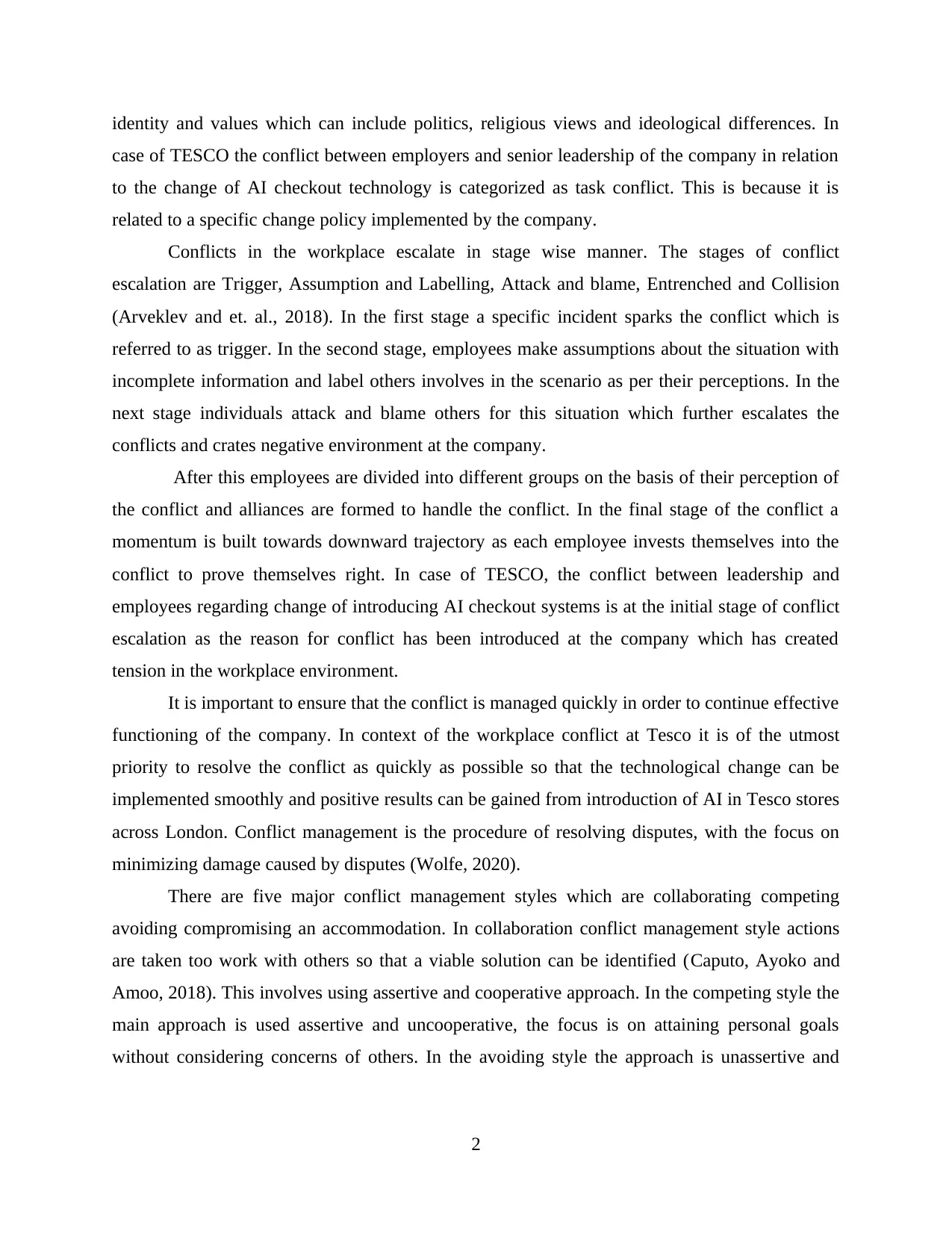
identity and values which can include politics, religious views and ideological differences. In
case of TESCO the conflict between employers and senior leadership of the company in relation
to the change of AI checkout technology is categorized as task conflict. This is because it is
related to a specific change policy implemented by the company.
Conflicts in the workplace escalate in stage wise manner. The stages of conflict
escalation are Trigger, Assumption and Labelling, Attack and blame, Entrenched and Collision
(Arveklev and et. al., 2018). In the first stage a specific incident sparks the conflict which is
referred to as trigger. In the second stage, employees make assumptions about the situation with
incomplete information and label others involves in the scenario as per their perceptions. In the
next stage individuals attack and blame others for this situation which further escalates the
conflicts and crates negative environment at the company.
After this employees are divided into different groups on the basis of their perception of
the conflict and alliances are formed to handle the conflict. In the final stage of the conflict a
momentum is built towards downward trajectory as each employee invests themselves into the
conflict to prove themselves right. In case of TESCO, the conflict between leadership and
employees regarding change of introducing AI checkout systems is at the initial stage of conflict
escalation as the reason for conflict has been introduced at the company which has created
tension in the workplace environment.
It is important to ensure that the conflict is managed quickly in order to continue effective
functioning of the company. In context of the workplace conflict at Tesco it is of the utmost
priority to resolve the conflict as quickly as possible so that the technological change can be
implemented smoothly and positive results can be gained from introduction of AI in Tesco stores
across London. Conflict management is the procedure of resolving disputes, with the focus on
minimizing damage caused by disputes (Wolfe, 2020).
There are five major conflict management styles which are collaborating competing
avoiding compromising an accommodation. In collaboration conflict management style actions
are taken too work with others so that a viable solution can be identified (Caputo, Ayoko and
Amoo, 2018). This involves using assertive and cooperative approach. In the competing style the
main approach is used assertive and uncooperative, the focus is on attaining personal goals
without considering concerns of others. In the avoiding style the approach is unassertive and
2
case of TESCO the conflict between employers and senior leadership of the company in relation
to the change of AI checkout technology is categorized as task conflict. This is because it is
related to a specific change policy implemented by the company.
Conflicts in the workplace escalate in stage wise manner. The stages of conflict
escalation are Trigger, Assumption and Labelling, Attack and blame, Entrenched and Collision
(Arveklev and et. al., 2018). In the first stage a specific incident sparks the conflict which is
referred to as trigger. In the second stage, employees make assumptions about the situation with
incomplete information and label others involves in the scenario as per their perceptions. In the
next stage individuals attack and blame others for this situation which further escalates the
conflicts and crates negative environment at the company.
After this employees are divided into different groups on the basis of their perception of
the conflict and alliances are formed to handle the conflict. In the final stage of the conflict a
momentum is built towards downward trajectory as each employee invests themselves into the
conflict to prove themselves right. In case of TESCO, the conflict between leadership and
employees regarding change of introducing AI checkout systems is at the initial stage of conflict
escalation as the reason for conflict has been introduced at the company which has created
tension in the workplace environment.
It is important to ensure that the conflict is managed quickly in order to continue effective
functioning of the company. In context of the workplace conflict at Tesco it is of the utmost
priority to resolve the conflict as quickly as possible so that the technological change can be
implemented smoothly and positive results can be gained from introduction of AI in Tesco stores
across London. Conflict management is the procedure of resolving disputes, with the focus on
minimizing damage caused by disputes (Wolfe, 2020).
There are five major conflict management styles which are collaborating competing
avoiding compromising an accommodation. In collaboration conflict management style actions
are taken too work with others so that a viable solution can be identified (Caputo, Ayoko and
Amoo, 2018). This involves using assertive and cooperative approach. In the competing style the
main approach is used assertive and uncooperative, the focus is on attaining personal goals
without considering concerns of others. In the avoiding style the approach is unassertive and
2
Paraphrase This Document
Need a fresh take? Get an instant paraphrase of this document with our AI Paraphraser
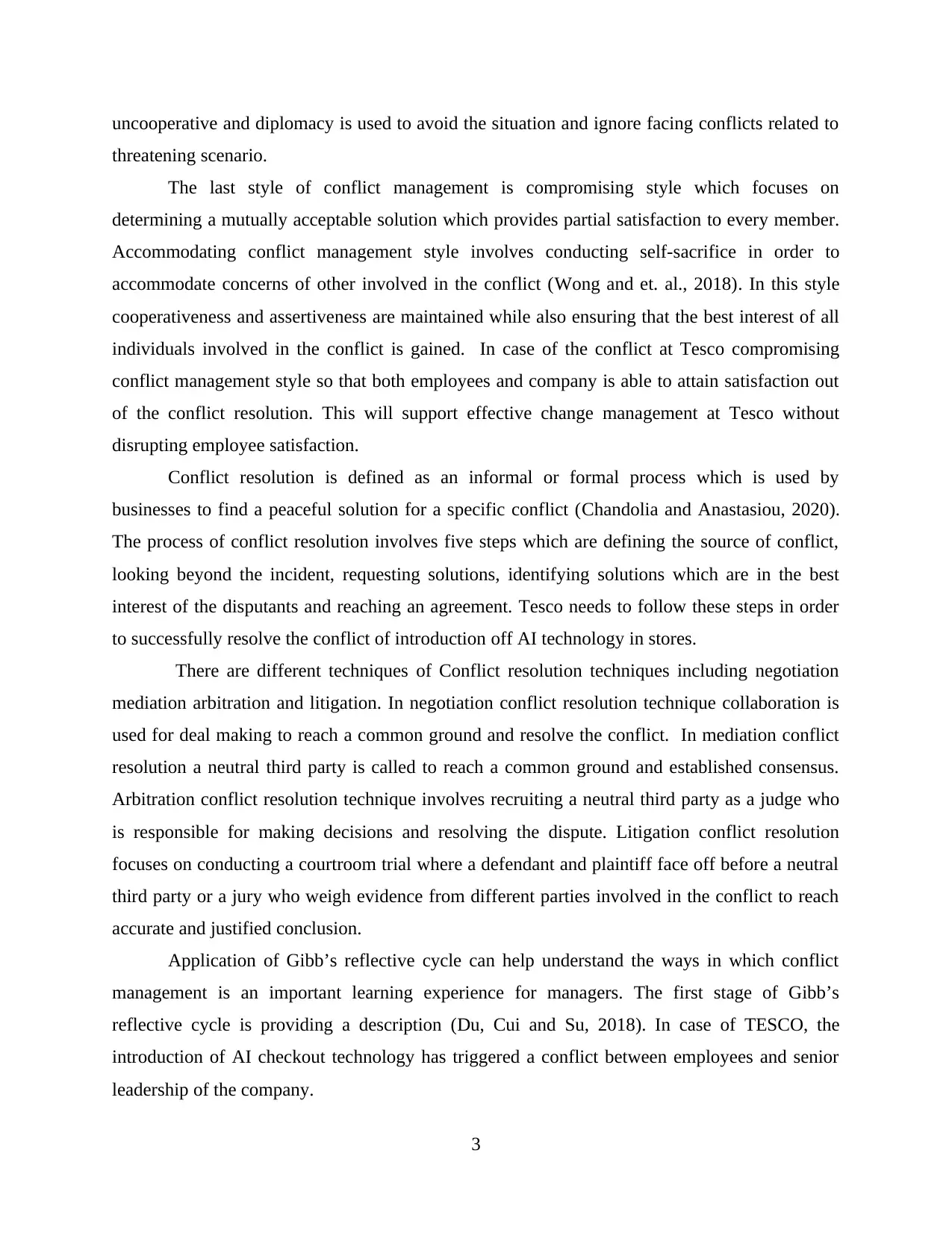
uncooperative and diplomacy is used to avoid the situation and ignore facing conflicts related to
threatening scenario.
The last style of conflict management is compromising style which focuses on
determining a mutually acceptable solution which provides partial satisfaction to every member.
Accommodating conflict management style involves conducting self-sacrifice in order to
accommodate concerns of other involved in the conflict (Wong and et. al., 2018). In this style
cooperativeness and assertiveness are maintained while also ensuring that the best interest of all
individuals involved in the conflict is gained. In case of the conflict at Tesco compromising
conflict management style so that both employees and company is able to attain satisfaction out
of the conflict resolution. This will support effective change management at Tesco without
disrupting employee satisfaction.
Conflict resolution is defined as an informal or formal process which is used by
businesses to find a peaceful solution for a specific conflict (Chandolia and Anastasiou, 2020).
The process of conflict resolution involves five steps which are defining the source of conflict,
looking beyond the incident, requesting solutions, identifying solutions which are in the best
interest of the disputants and reaching an agreement. Tesco needs to follow these steps in order
to successfully resolve the conflict of introduction off AI technology in stores.
There are different techniques of Conflict resolution techniques including negotiation
mediation arbitration and litigation. In negotiation conflict resolution technique collaboration is
used for deal making to reach a common ground and resolve the conflict. In mediation conflict
resolution a neutral third party is called to reach a common ground and established consensus.
Arbitration conflict resolution technique involves recruiting a neutral third party as a judge who
is responsible for making decisions and resolving the dispute. Litigation conflict resolution
focuses on conducting a courtroom trial where a defendant and plaintiff face off before a neutral
third party or a jury who weigh evidence from different parties involved in the conflict to reach
accurate and justified conclusion.
Application of Gibb’s reflective cycle can help understand the ways in which conflict
management is an important learning experience for managers. The first stage of Gibb’s
reflective cycle is providing a description (Du, Cui and Su, 2018). In case of TESCO, the
introduction of AI checkout technology has triggered a conflict between employees and senior
leadership of the company.
3
threatening scenario.
The last style of conflict management is compromising style which focuses on
determining a mutually acceptable solution which provides partial satisfaction to every member.
Accommodating conflict management style involves conducting self-sacrifice in order to
accommodate concerns of other involved in the conflict (Wong and et. al., 2018). In this style
cooperativeness and assertiveness are maintained while also ensuring that the best interest of all
individuals involved in the conflict is gained. In case of the conflict at Tesco compromising
conflict management style so that both employees and company is able to attain satisfaction out
of the conflict resolution. This will support effective change management at Tesco without
disrupting employee satisfaction.
Conflict resolution is defined as an informal or formal process which is used by
businesses to find a peaceful solution for a specific conflict (Chandolia and Anastasiou, 2020).
The process of conflict resolution involves five steps which are defining the source of conflict,
looking beyond the incident, requesting solutions, identifying solutions which are in the best
interest of the disputants and reaching an agreement. Tesco needs to follow these steps in order
to successfully resolve the conflict of introduction off AI technology in stores.
There are different techniques of Conflict resolution techniques including negotiation
mediation arbitration and litigation. In negotiation conflict resolution technique collaboration is
used for deal making to reach a common ground and resolve the conflict. In mediation conflict
resolution a neutral third party is called to reach a common ground and established consensus.
Arbitration conflict resolution technique involves recruiting a neutral third party as a judge who
is responsible for making decisions and resolving the dispute. Litigation conflict resolution
focuses on conducting a courtroom trial where a defendant and plaintiff face off before a neutral
third party or a jury who weigh evidence from different parties involved in the conflict to reach
accurate and justified conclusion.
Application of Gibb’s reflective cycle can help understand the ways in which conflict
management is an important learning experience for managers. The first stage of Gibb’s
reflective cycle is providing a description (Du, Cui and Su, 2018). In case of TESCO, the
introduction of AI checkout technology has triggered a conflict between employees and senior
leadership of the company.
3

The next stage of Gibb’s reflective cycle is describing the feelings and thoughts about the
experience. In this stage the managers can learn about their perceptions about the conflict event.
In case of TESCO, the positive feelings include ability of employees to voice their concerns
about leadership decisions while the negative feeling was related to opposite repose of
employees. In the next stage the situation is evaluated which helps managers identify areas of the
conflict which did support conflict management and areas which did not support conflict
management (Grubaugh and Flynn, 2018). In case of TESCO, the areas which worked in favour
of conflict management included effective communication skills of the leadership while areas
which did not work in favour of conflict management is the lack of training initiatives which
helped employees learn more about the new AI technology which is being introduced.
The next stage involves analysis which can help managers understand the strengths and
weaknesses of the overall conflict management experience and increase their decision making
abilities for the next conflict through analysis. The strength of the conflict management
experience at TESCO was that coaching technique was used to train employees to handle AI
checkout and communicate the benefits of this change for different employees. The weak aspects
of conflict management experience were the decrease in employee involvement in various
training activities because of the high employee dissatisfaction.
In the final stage of the reflective cycle an accurate conclusion is drawn to develop an
overview of the overall experience. In case of TESOC coaching techniques played an important
role in resolving conflict but there is need to ensure improvement in employee involvement to
enhance effectiveness of coaching and training initiatives. After this a suitable action plan is
created to move forward with effective conflict management (Kluczewska, 2020). In case of
conflict at TESOC the plan needs to involve a motivation scheme which increases employee
involvement in coaching activities so that conflicts can be managed effectively.
Conflicts are better resolved than managed. This is because conflict resolution leads to
the end of the conflict and elimination of root cause the conflict. This helps ensure that the
conflict will not arise in the future, which is better in comparison to conflict management as
there is possibility of conflict arising again (Lu and Wang, 2017).
Coaching is defined as the act of an expert providing their assistance to an individual for
their improvement. On the other hand mentoring is defined as in which an individual acts as a
guide for less experienced person. The main difference between coaching requires services of an
4
experience. In this stage the managers can learn about their perceptions about the conflict event.
In case of TESCO, the positive feelings include ability of employees to voice their concerns
about leadership decisions while the negative feeling was related to opposite repose of
employees. In the next stage the situation is evaluated which helps managers identify areas of the
conflict which did support conflict management and areas which did not support conflict
management (Grubaugh and Flynn, 2018). In case of TESCO, the areas which worked in favour
of conflict management included effective communication skills of the leadership while areas
which did not work in favour of conflict management is the lack of training initiatives which
helped employees learn more about the new AI technology which is being introduced.
The next stage involves analysis which can help managers understand the strengths and
weaknesses of the overall conflict management experience and increase their decision making
abilities for the next conflict through analysis. The strength of the conflict management
experience at TESCO was that coaching technique was used to train employees to handle AI
checkout and communicate the benefits of this change for different employees. The weak aspects
of conflict management experience were the decrease in employee involvement in various
training activities because of the high employee dissatisfaction.
In the final stage of the reflective cycle an accurate conclusion is drawn to develop an
overview of the overall experience. In case of TESOC coaching techniques played an important
role in resolving conflict but there is need to ensure improvement in employee involvement to
enhance effectiveness of coaching and training initiatives. After this a suitable action plan is
created to move forward with effective conflict management (Kluczewska, 2020). In case of
conflict at TESOC the plan needs to involve a motivation scheme which increases employee
involvement in coaching activities so that conflicts can be managed effectively.
Conflicts are better resolved than managed. This is because conflict resolution leads to
the end of the conflict and elimination of root cause the conflict. This helps ensure that the
conflict will not arise in the future, which is better in comparison to conflict management as
there is possibility of conflict arising again (Lu and Wang, 2017).
Coaching is defined as the act of an expert providing their assistance to an individual for
their improvement. On the other hand mentoring is defined as in which an individual acts as a
guide for less experienced person. The main difference between coaching requires services of an
4
⊘ This is a preview!⊘
Do you want full access?
Subscribe today to unlock all pages.

Trusted by 1+ million students worldwide
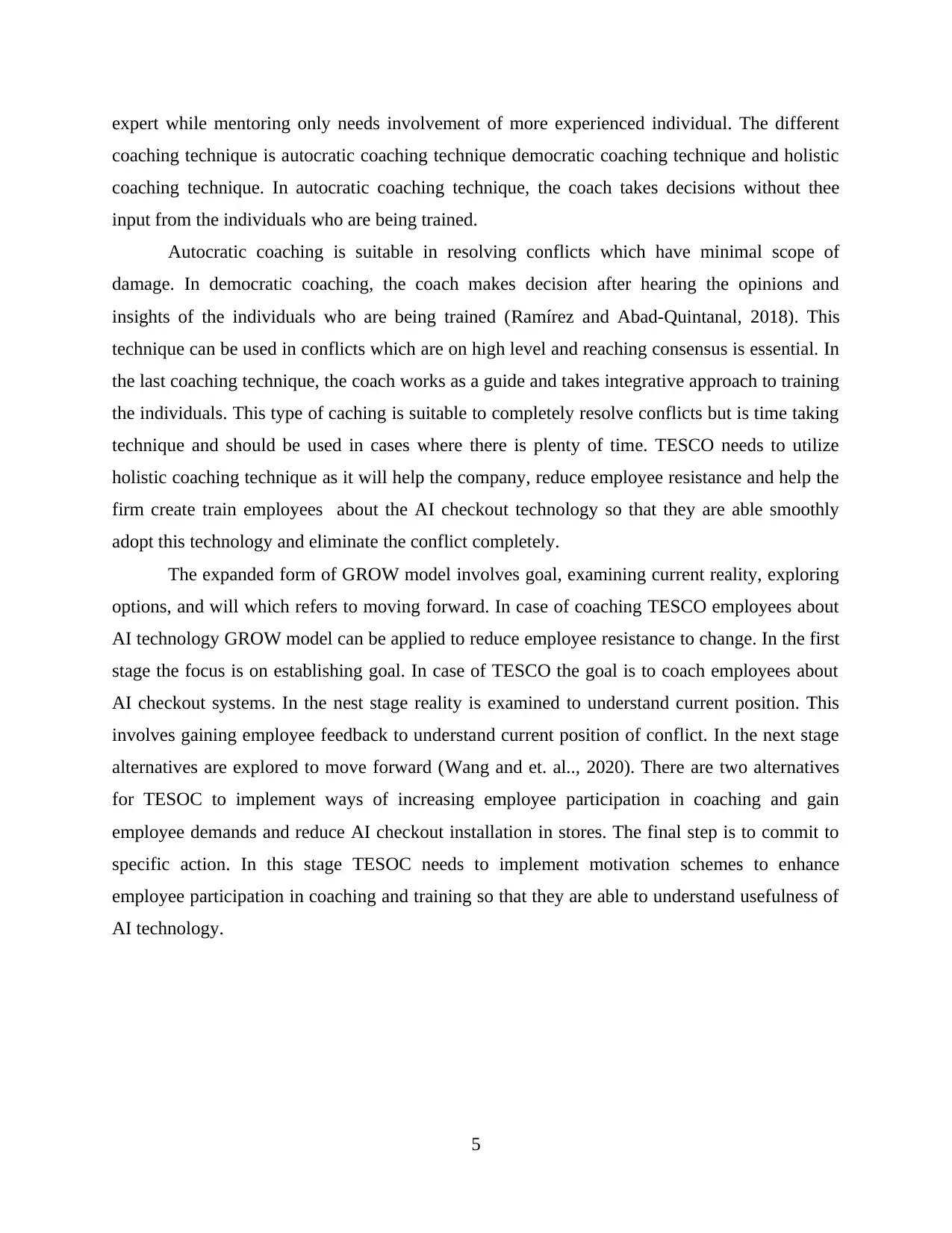
expert while mentoring only needs involvement of more experienced individual. The different
coaching technique is autocratic coaching technique democratic coaching technique and holistic
coaching technique. In autocratic coaching technique, the coach takes decisions without thee
input from the individuals who are being trained.
Autocratic coaching is suitable in resolving conflicts which have minimal scope of
damage. In democratic coaching, the coach makes decision after hearing the opinions and
insights of the individuals who are being trained (Ramírez and Abad-Quintanal, 2018). This
technique can be used in conflicts which are on high level and reaching consensus is essential. In
the last coaching technique, the coach works as a guide and takes integrative approach to training
the individuals. This type of caching is suitable to completely resolve conflicts but is time taking
technique and should be used in cases where there is plenty of time. TESCO needs to utilize
holistic coaching technique as it will help the company, reduce employee resistance and help the
firm create train employees about the AI checkout technology so that they are able smoothly
adopt this technology and eliminate the conflict completely.
The expanded form of GROW model involves goal, examining current reality, exploring
options, and will which refers to moving forward. In case of coaching TESCO employees about
AI technology GROW model can be applied to reduce employee resistance to change. In the first
stage the focus is on establishing goal. In case of TESCO the goal is to coach employees about
AI checkout systems. In the nest stage reality is examined to understand current position. This
involves gaining employee feedback to understand current position of conflict. In the next stage
alternatives are explored to move forward (Wang and et. al.., 2020). There are two alternatives
for TESOC to implement ways of increasing employee participation in coaching and gain
employee demands and reduce AI checkout installation in stores. The final step is to commit to
specific action. In this stage TESOC needs to implement motivation schemes to enhance
employee participation in coaching and training so that they are able to understand usefulness of
AI technology.
5
coaching technique is autocratic coaching technique democratic coaching technique and holistic
coaching technique. In autocratic coaching technique, the coach takes decisions without thee
input from the individuals who are being trained.
Autocratic coaching is suitable in resolving conflicts which have minimal scope of
damage. In democratic coaching, the coach makes decision after hearing the opinions and
insights of the individuals who are being trained (Ramírez and Abad-Quintanal, 2018). This
technique can be used in conflicts which are on high level and reaching consensus is essential. In
the last coaching technique, the coach works as a guide and takes integrative approach to training
the individuals. This type of caching is suitable to completely resolve conflicts but is time taking
technique and should be used in cases where there is plenty of time. TESCO needs to utilize
holistic coaching technique as it will help the company, reduce employee resistance and help the
firm create train employees about the AI checkout technology so that they are able smoothly
adopt this technology and eliminate the conflict completely.
The expanded form of GROW model involves goal, examining current reality, exploring
options, and will which refers to moving forward. In case of coaching TESCO employees about
AI technology GROW model can be applied to reduce employee resistance to change. In the first
stage the focus is on establishing goal. In case of TESCO the goal is to coach employees about
AI checkout systems. In the nest stage reality is examined to understand current position. This
involves gaining employee feedback to understand current position of conflict. In the next stage
alternatives are explored to move forward (Wang and et. al.., 2020). There are two alternatives
for TESOC to implement ways of increasing employee participation in coaching and gain
employee demands and reduce AI checkout installation in stores. The final step is to commit to
specific action. In this stage TESOC needs to implement motivation schemes to enhance
employee participation in coaching and training so that they are able to understand usefulness of
AI technology.
5
Paraphrase This Document
Need a fresh take? Get an instant paraphrase of this document with our AI Paraphraser
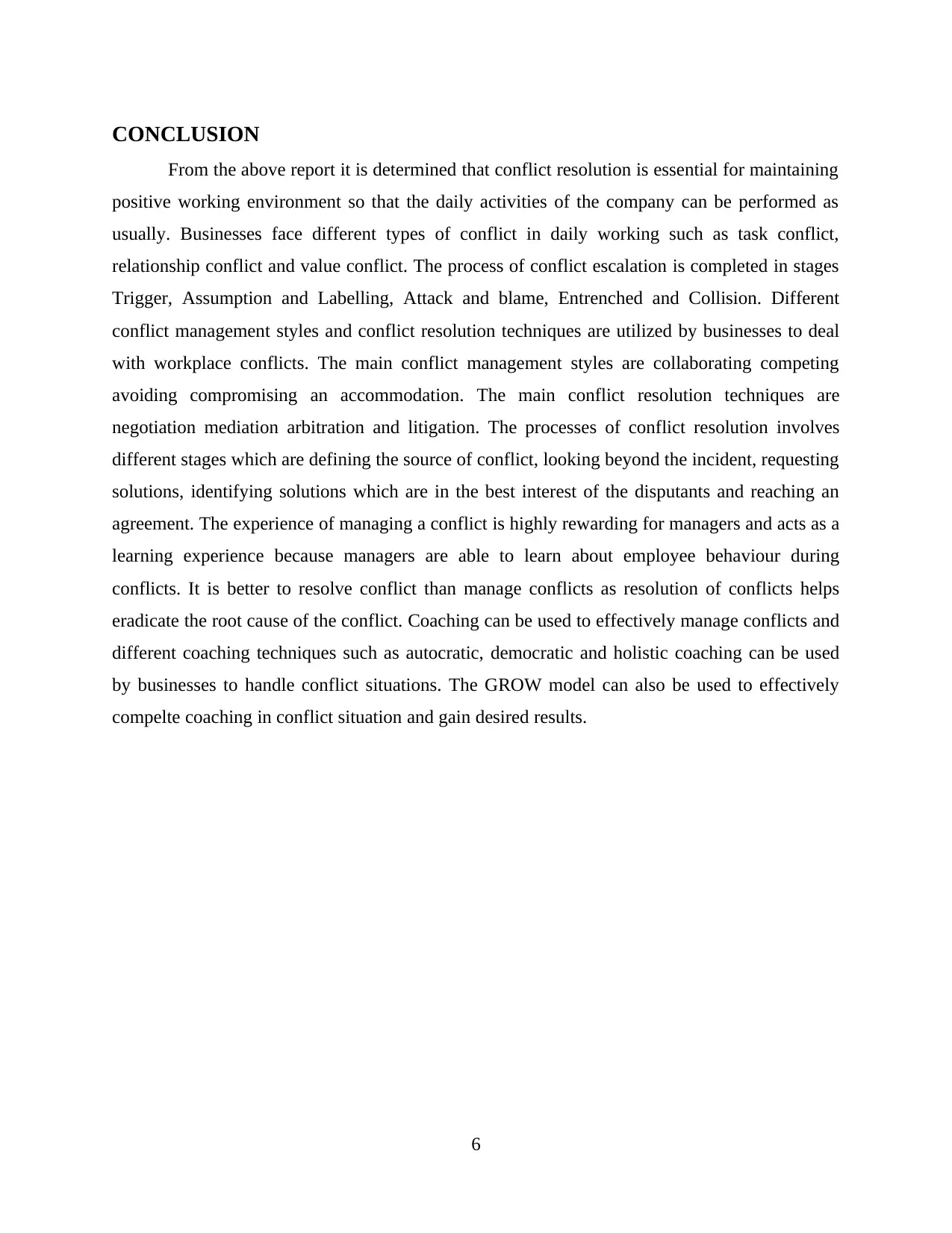
CONCLUSION
From the above report it is determined that conflict resolution is essential for maintaining
positive working environment so that the daily activities of the company can be performed as
usually. Businesses face different types of conflict in daily working such as task conflict,
relationship conflict and value conflict. The process of conflict escalation is completed in stages
Trigger, Assumption and Labelling, Attack and blame, Entrenched and Collision. Different
conflict management styles and conflict resolution techniques are utilized by businesses to deal
with workplace conflicts. The main conflict management styles are collaborating competing
avoiding compromising an accommodation. The main conflict resolution techniques are
negotiation mediation arbitration and litigation. The processes of conflict resolution involves
different stages which are defining the source of conflict, looking beyond the incident, requesting
solutions, identifying solutions which are in the best interest of the disputants and reaching an
agreement. The experience of managing a conflict is highly rewarding for managers and acts as a
learning experience because managers are able to learn about employee behaviour during
conflicts. It is better to resolve conflict than manage conflicts as resolution of conflicts helps
eradicate the root cause of the conflict. Coaching can be used to effectively manage conflicts and
different coaching techniques such as autocratic, democratic and holistic coaching can be used
by businesses to handle conflict situations. The GROW model can also be used to effectively
compelte coaching in conflict situation and gain desired results.
6
From the above report it is determined that conflict resolution is essential for maintaining
positive working environment so that the daily activities of the company can be performed as
usually. Businesses face different types of conflict in daily working such as task conflict,
relationship conflict and value conflict. The process of conflict escalation is completed in stages
Trigger, Assumption and Labelling, Attack and blame, Entrenched and Collision. Different
conflict management styles and conflict resolution techniques are utilized by businesses to deal
with workplace conflicts. The main conflict management styles are collaborating competing
avoiding compromising an accommodation. The main conflict resolution techniques are
negotiation mediation arbitration and litigation. The processes of conflict resolution involves
different stages which are defining the source of conflict, looking beyond the incident, requesting
solutions, identifying solutions which are in the best interest of the disputants and reaching an
agreement. The experience of managing a conflict is highly rewarding for managers and acts as a
learning experience because managers are able to learn about employee behaviour during
conflicts. It is better to resolve conflict than manage conflicts as resolution of conflicts helps
eradicate the root cause of the conflict. Coaching can be used to effectively manage conflicts and
different coaching techniques such as autocratic, democratic and holistic coaching can be used
by businesses to handle conflict situations. The GROW model can also be used to effectively
compelte coaching in conflict situation and gain desired results.
6
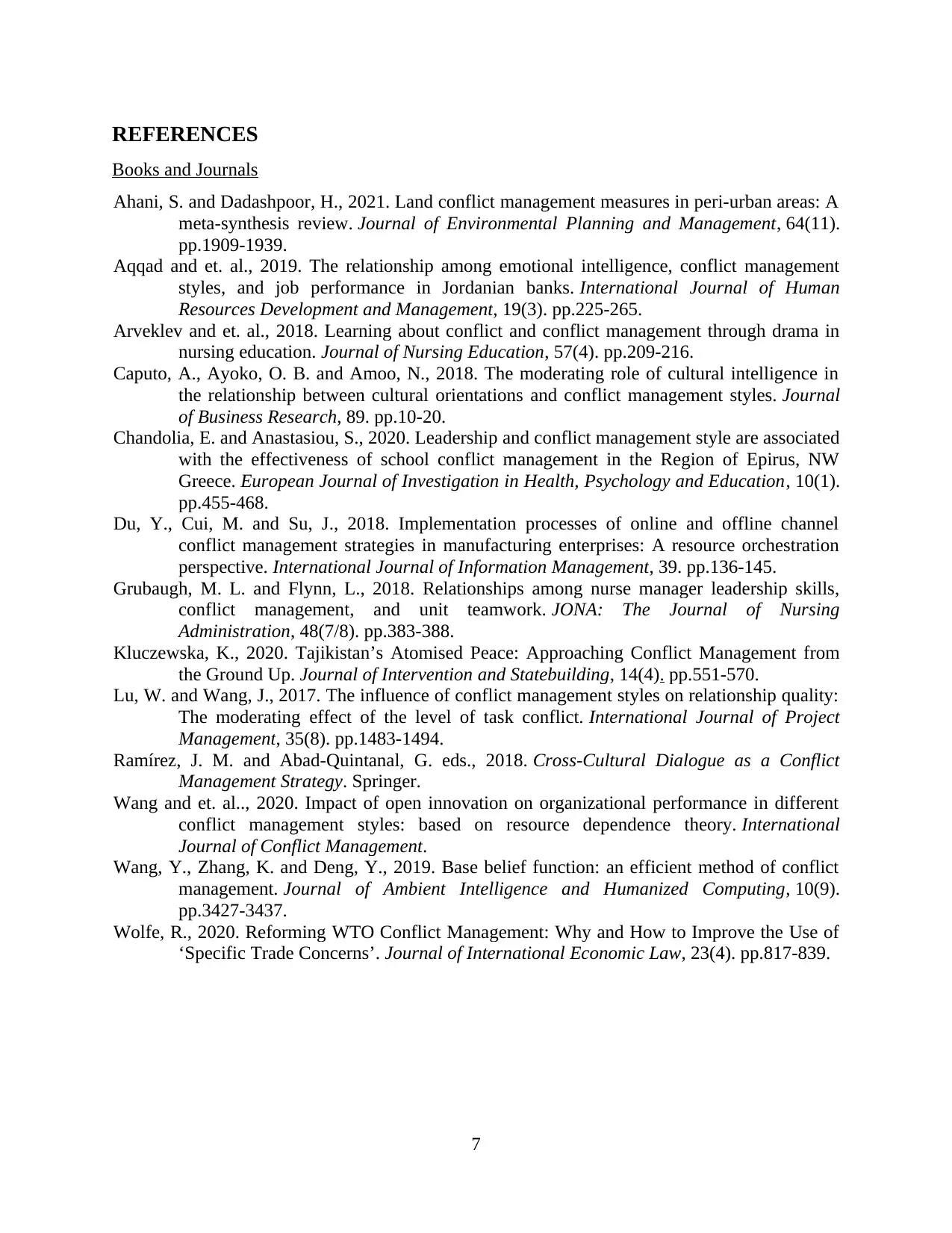
REFERENCES
Books and Journals
Ahani, S. and Dadashpoor, H., 2021. Land conflict management measures in peri-urban areas: A
meta-synthesis review. Journal of Environmental Planning and Management, 64(11).
pp.1909-1939.
Aqqad and et. al., 2019. The relationship among emotional intelligence, conflict management
styles, and job performance in Jordanian banks. International Journal of Human
Resources Development and Management, 19(3). pp.225-265.
Arveklev and et. al., 2018. Learning about conflict and conflict management through drama in
nursing education. Journal of Nursing Education, 57(4). pp.209-216.
Caputo, A., Ayoko, O. B. and Amoo, N., 2018. The moderating role of cultural intelligence in
the relationship between cultural orientations and conflict management styles. Journal
of Business Research, 89. pp.10-20.
Chandolia, E. and Anastasiou, S., 2020. Leadership and conflict management style are associated
with the effectiveness of school conflict management in the Region of Epirus, NW
Greece. European Journal of Investigation in Health, Psychology and Education, 10(1).
pp.455-468.
Du, Y., Cui, M. and Su, J., 2018. Implementation processes of online and offline channel
conflict management strategies in manufacturing enterprises: A resource orchestration
perspective. International Journal of Information Management, 39. pp.136-145.
Grubaugh, M. L. and Flynn, L., 2018. Relationships among nurse manager leadership skills,
conflict management, and unit teamwork. JONA: The Journal of Nursing
Administration, 48(7/8). pp.383-388.
Kluczewska, K., 2020. Tajikistan’s Atomised Peace: Approaching Conflict Management from
the Ground Up. Journal of Intervention and Statebuilding, 14(4). pp.551-570.
Lu, W. and Wang, J., 2017. The influence of conflict management styles on relationship quality:
The moderating effect of the level of task conflict. International Journal of Project
Management, 35(8). pp.1483-1494.
Ramírez, J. M. and Abad-Quintanal, G. eds., 2018. Cross-Cultural Dialogue as a Conflict
Management Strategy. Springer.
Wang and et. al.., 2020. Impact of open innovation on organizational performance in different
conflict management styles: based on resource dependence theory. International
Journal of Conflict Management.
Wang, Y., Zhang, K. and Deng, Y., 2019. Base belief function: an efficient method of conflict
management. Journal of Ambient Intelligence and Humanized Computing, 10(9).
pp.3427-3437.
Wolfe, R., 2020. Reforming WTO Conflict Management: Why and How to Improve the Use of
‘Specific Trade Concerns’. Journal of International Economic Law, 23(4). pp.817-839.
7
Books and Journals
Ahani, S. and Dadashpoor, H., 2021. Land conflict management measures in peri-urban areas: A
meta-synthesis review. Journal of Environmental Planning and Management, 64(11).
pp.1909-1939.
Aqqad and et. al., 2019. The relationship among emotional intelligence, conflict management
styles, and job performance in Jordanian banks. International Journal of Human
Resources Development and Management, 19(3). pp.225-265.
Arveklev and et. al., 2018. Learning about conflict and conflict management through drama in
nursing education. Journal of Nursing Education, 57(4). pp.209-216.
Caputo, A., Ayoko, O. B. and Amoo, N., 2018. The moderating role of cultural intelligence in
the relationship between cultural orientations and conflict management styles. Journal
of Business Research, 89. pp.10-20.
Chandolia, E. and Anastasiou, S., 2020. Leadership and conflict management style are associated
with the effectiveness of school conflict management in the Region of Epirus, NW
Greece. European Journal of Investigation in Health, Psychology and Education, 10(1).
pp.455-468.
Du, Y., Cui, M. and Su, J., 2018. Implementation processes of online and offline channel
conflict management strategies in manufacturing enterprises: A resource orchestration
perspective. International Journal of Information Management, 39. pp.136-145.
Grubaugh, M. L. and Flynn, L., 2018. Relationships among nurse manager leadership skills,
conflict management, and unit teamwork. JONA: The Journal of Nursing
Administration, 48(7/8). pp.383-388.
Kluczewska, K., 2020. Tajikistan’s Atomised Peace: Approaching Conflict Management from
the Ground Up. Journal of Intervention and Statebuilding, 14(4). pp.551-570.
Lu, W. and Wang, J., 2017. The influence of conflict management styles on relationship quality:
The moderating effect of the level of task conflict. International Journal of Project
Management, 35(8). pp.1483-1494.
Ramírez, J. M. and Abad-Quintanal, G. eds., 2018. Cross-Cultural Dialogue as a Conflict
Management Strategy. Springer.
Wang and et. al.., 2020. Impact of open innovation on organizational performance in different
conflict management styles: based on resource dependence theory. International
Journal of Conflict Management.
Wang, Y., Zhang, K. and Deng, Y., 2019. Base belief function: an efficient method of conflict
management. Journal of Ambient Intelligence and Humanized Computing, 10(9).
pp.3427-3437.
Wolfe, R., 2020. Reforming WTO Conflict Management: Why and How to Improve the Use of
‘Specific Trade Concerns’. Journal of International Economic Law, 23(4). pp.817-839.
7
⊘ This is a preview!⊘
Do you want full access?
Subscribe today to unlock all pages.

Trusted by 1+ million students worldwide
1 out of 9
Related Documents
Your All-in-One AI-Powered Toolkit for Academic Success.
+13062052269
info@desklib.com
Available 24*7 on WhatsApp / Email
![[object Object]](/_next/static/media/star-bottom.7253800d.svg)
Unlock your academic potential
Copyright © 2020–2025 A2Z Services. All Rights Reserved. Developed and managed by ZUCOL.





